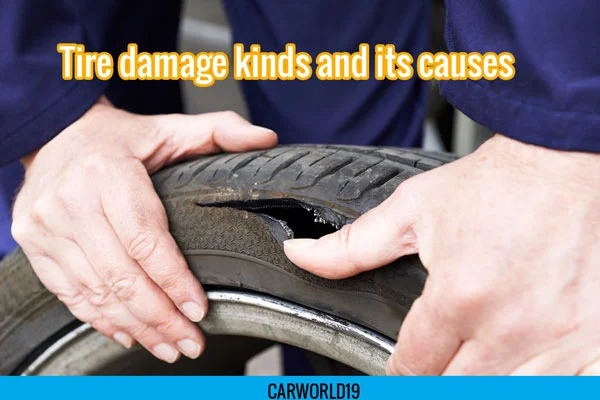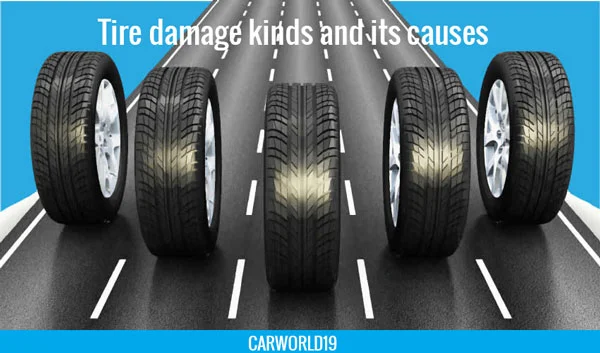Tires can sustain damage from several causes without the driver being immediately aware of a problem.
The most frequent kinds of damage are rips, cuts, collisions, bulges, cracks, and asymmetrical wear.
In this part, we'll go through the symptoms and indicators that may be used to diagnose the problem, as well as some helpful advice on how to avoid them.
 |
| Tire damage kinds and its causes |
Detecting unusual wear
There are several sorts of irregular wear, with heel and toe wear, one-sided wear, and center wear being the most prevalent varieties. Here, we describe how and why they take place.
Wearing heels and toes
A common pattern brought on by everyday use and suspension settings is heel and toe wear. It is the externally apparent (and audible) result of many distorting forces operating on the tread. Let's delve a bit further into the tread design to clarify.
On flooded and wet roads, tread grooves and sips are crucial for guaranteeing safety. A larger proportion of tread void is required, especially with low-profile tires, to better absorb water and prevent aquaplaning.
In the shoulder region, cross grooves for water drainage take the shape of freestanding blocks. Rolling mechanisms may cause these shoulder blocks to develop a heel and toe pattern under specific operating circumstances.
These operational circumstances consist of:
- Long distances traveled with a constant speed on straight highways.
- A reasonable driving style.
- The suspension geometry's alignment and camber.
The unsupported blocks distort as they get close to the tire's contact patch as the tire is traveling down the road, and they compress once they make contact with the pavement.
The blocks will return to their former shape after losing road contact, scratching the ground as they do so. As a result, the block run-out edge develops a wear pattern that is more likely to be visible on undriven wheel locations.
It is okay to have some heel and toe pattern wear, and it has no obvious influence on how comfortable it is to drive. However, if the wear is more severe, additional particular problems could be to blame. These can include low-wear applications, excessive toe-in, and inappropriate inflation.
Center wear
This wear pattern may be seen on the driven wheels of highly propelled vehicles. These high torque levels can quickly exacerbate tread center wear when accelerating vigorously, in stop-start urban traffic, or while driving past traffic signals.
Even today's mid-range cars are equipped with cutting-edge engines that can produce a lot of torque and a lot of slip.
b. Unilateral wear
Axle geometry is the single largest cause of one-sided wear. Deviations are possible over time and are brought on by actions like obstinately mounting a curb.
Wheel alignment can also be impacted by low-profile tires and vehicle height reduction. Wheel alignment tends to wander from the desired position during driving due to changed suspension arms. Because wheel alignment readings can still be determined to be within tolerance limits when evaluated in a static position on an axle measuring bench, the issue might catch drivers off guard.
However, the manufacturer's alignment data only applies to vehicles that are delivered in their original configuration. As a result, there can be an increase in uneven tread wear.
A skilled expert can realign the wheels of a vehicle whose wheels are out of alignment to fix the deviation.
How to see an impact break or bulge?
An impact break occurs when the tire's carcass, or casing, sustains damage as a result of coming into contact with particular objects. The tire's sidewall has a noticeable bulge, which is an indication of damaged cables inside the carcass.
This form of damage is typically brought on by hitting obstructions, such as curbs or speed bumps, too quickly or at an incorrect angle. Individual cords break when the carcass is put under too much strain.
The precise amount of damage will vary depending on the speed, angle, and size of the obstruction. Unless an obstruction suddenly surfaces in front of a car, and they are unable to maneuver around it, cautious drivers are typically able to prevent this kind of harm.
Ignoring such damage raises the possibility of future tire failure, such as sidewall disintegration or tread and plies deamination.
Although they are not the same thing, an impact break and a sidewall depression are occasionally mistaken for one another. Dimples or indentations in the sidewall are not the reason for concern, as we will explain later.
Knowing where a sidewall indentation is
It may be necessary to conduct a more thorough investigation to identify the sources of dimples and indentations on a tire sidewall because they are not always precisely even.
The most important thing to understand is that indentations are safe and don't affect driving or safety abilities. The lumps are only surface-level.
The simplest way to see tire indentations is to picture tying a string around an inflated balloon and then gradually tugging the string tighter.
If the tire is the balloon, the embedded carcass cords that are hidden by the rubber are the string. These cables transmit steering and braking forces while driving and provide the tire its strength and stability.
There are frequently one or two overlaps in the tire carcass, which is constructed during tire manufacturing, and to which the steel belt and tread are linked. After the tire is mounted and inflated, this overlap can occasionally be seen as an indentation.
But if you're unsure, have a certified tire technician examine the sidewall indentations.
Recognizing a cut
Cuts are caused by outside factors such as poor road conditions, sticking bodywork, or sharp, foreign items like stones or glass. Visit your neighborhood tire shop right away to get your tires professionally inspected if you see damage in the form of a cut on the tire surface.
Described are punctures
Punctures happen when sharp items on the road, such as nails, screws, or pieces of shattered glass, puncture the tire's surface. The tire may start to lose air pressure if the hole is deep enough.
Visit your neighborhood tire specialist as soon as you can to get them fixed if you notice that one or more of your tires are consistently losing pressure or if you find a nail or screw embedded in the tread.
How to stop damage
To encourage even tire wear, move the tires on the automobile at regular intervals (unless the vehicle manufacturer advises differently). For instance, when switching from summer to winter tires for the season, the position of the tires should be rotated.
Drivers can anticipate a similar pattern of tire wear by often switching the wheels from the powered to the non-powered axle. But as always, heed the manufacturer's instructions when operating a vehicle.
If you ever find yourself having to drive over an obstruction in the road, make sure to do it carefully and as perpendicularly as you can. After that, look for external flaws on your tires like cuts, cracks, or bulges. Additionally, drive carefully on unpaved roads.

